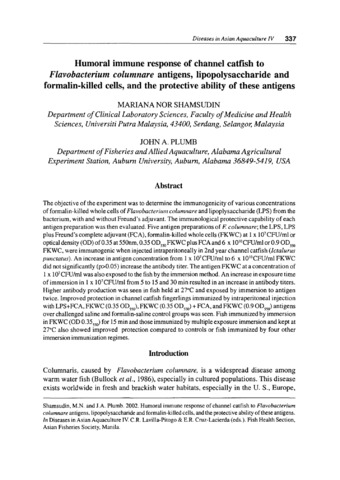Humoral immune response of channel catfish to Flavobacterium columnare antigens, lipopolysaccharide and formalin-killed cells, and the protective ability of these antigens
- Global styles
- MLA
- Vancouver
- Elsevier - Harvard
- APA
- Help

ดู/
วันที่
2002Page views
652ASFA keyword
AGROVOC keyword
Taxonomic term
เมตาดาต้า
แสดงระเบียนรายการเต็ม
Share
นามธรรม
The objective of the experiment was to determine the immunogenicity of various concentrations of formalin-killed whole cells of Flavobacterium columnare and lipopolysaccharide (LPS) from the bacterium, with and without Freund s adjuvant. The immunological protective capability of each antigen preparation was then evaluated. Five antigen preparations of F. columnare; the LPS, LPS plus Freund s complete adjuvant (FCA), formalin-killed whole cells (FKWC) at 1 x 107CFU/ml or optical density (OD) of 0.35 at550 nm, 0.35 OD550 FKWC plus FCA and 6 x 1010 CFU/ml or 0.9 OD550 FKWC, were immunogenic when injected intraperitoneally in 2nd year channel catfish (Ictalurus punctatus). An increase in antigen concentration from 1 x 107CFU/ml to 6 x 1010 CFU/ml FKWC did not significantly (p>0.05) increase the antibody titer. The antigen FKWC at a concentration of 1 x 107 CFU/ml was also exposed to the fish by the immersion method. An increase in exposure time of immersion in 1 x 107 CFU/ml from 5 to 15 and 30 min resulted in an increase in antibody titers. Higher antibody production was seen in fish held at 27°C and exposed by immersion to antigen twice. Improved protection in channel catfish fingerlings immunized by intraperitoneal injection with LPS+FCA, FKWC (0.35 OD550), FKWC (0.35 OD550) + FCA, and FKWC (0.9 OD550) antigens over challenged saline and formalin-saline control groups was seen. Fish immunized by immersion in FKWC (OD 0.35550) for 15 min and those immunized by multiple exposure immersion and kept at 27°C also showed improved protection compared to controls or fish immunized by four other immersion immunization regimes.
การอ้างอิง
Shamsudin, M. N., & Plumb, J. A. (2002). Humoral immune response of channel catfish to Flavobacterium columnare antigens, lipopolysaccharide and formalin-killed cells, and the protective ability of these antigens. In C. R. Lavilla-Pitogo & E. R. Cruz-Lacierda (Eds.), Diseases in Asian aquaculture IV: Proceedings of the Fourth Symposium on Diseases in Asian Aquaculture, 22-26 November 1999, Cebu City, Philippines (pp. 337-348). Fish Health Section, Asian Fisheries Society.
Type
Conference paperISBN
9718020160คอลเลกชัน
Related items
Showing items related by title, author, creator and subject.
-
Dietary onion and ginger enhance growth, hemato-immunological responses, and disease resistance in brown-marbled grouper, Epinephelus fuscoguttatus
Apines-Amar, Mary Jane S.; Amar, Edgar C. ; Faisan, Joseph P., Jr.
; Faisan, Joseph P., Jr.  ; Pakingking, Rolando V., Jr.
; Pakingking, Rolando V., Jr.  ; Satoh, Shuichi (Bioflux, 2012)
A 12-week (September to December 2009) feeding trial was conducted to evaluate theimmunostimulatory effects of different substances administered orally through the diet in the brown-marbled grouper, Epinephelus fuscoguttatus. ...
; Satoh, Shuichi (Bioflux, 2012)
A 12-week (September to December 2009) feeding trial was conducted to evaluate theimmunostimulatory effects of different substances administered orally through the diet in the brown-marbled grouper, Epinephelus fuscoguttatus. ... -
Induction of immunity and resistance to white spot syndrome virus (WSSV) in shrimp Penaeus monodon (Fabricius) by synthetic oligodeoxynucleotide and bacterial DNA
Shrimps like all invertebrates are believed to lack true adaptive immunity but recent evidence indicate that they can be protected against pathogenic organisms by priming their immune system with immunostimulatory substances. ... -
Evaluation of dietary freeze-dried Chaetoceros calcitrans supplementation to control Vibrio harveyi infection on Penaeus monodon juvenile
Seraspe, Ebonia B.; Gabotero, Shirleny; de la Peña, Milagros R.; Pahila, Ida G.; Amar, Edgar (Elsevier, 2014)
Effects of supplementation of diets with freeze-dried Chaetoceros calcitrans to control Vibrio harveyi infection are evaluated through immune responses, and disease resistance of juvenile Penaeus monodon. Total lipid and ...
(Elsevier, 2014)
Effects of supplementation of diets with freeze-dried Chaetoceros calcitrans to control Vibrio harveyi infection are evaluated through immune responses, and disease resistance of juvenile Penaeus monodon. Total lipid and ...





